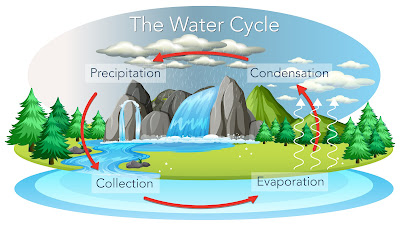Postingan update
- Dapatkan link
- X
- Aplikasi Lainnya
Despite making up such a little portion of the atmosphere, water has a significant impact on weather. While other places have no atmospheric water at all, some regions' local atmospheres may contain as much as 4% water. Water participates in the hydrologic cycle because it can exist as a solid, liquid, or gas under normal atmospheric circumstances. In this cycle, water leaves the ocean as water vapor and eventually makes its way back to land and the sea as precipitation.
Water vapor is invisible, but as it cools and condenses against something, it becomes clearly visible. Condensation can be seen in action if you've ever spotted droplets of moisture on the glass of a heated car on a chilly day. When warm air vapor comes in contact with a cold window, it becomes liquid again. Similar principles govern how clouds arise. Small dust particles known as condensation nuclei, which are produced by volcanic eruptions, dust storms, fires, and pollutants, are abundant in the atmosphere. These tiny flecks stick to the water vapor when it condenses. These build up in trillions to produce clouds if the air contains enough cooling water vapor. When temperatures drop low enough, the water around the condensation nuclei freezes.
These water droplets would fall back to the ground if there were no wind, but Earth's intricate upper air winds hold the clouds aloft while transporting them over great distances and changing their shape. The water will return to the surface if too much water condenses around a particle or if the air temperature lowers. While frozen particles fall as snow, liquid particles fall as rain. Rain that freezes as it is falling is known as freezing rain. Sometimes an updraft carries rain to higher, colder altitudes where the raindrops freeze and fall to Earth as hailstones.

Komentar